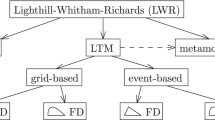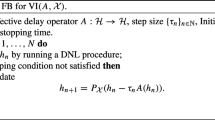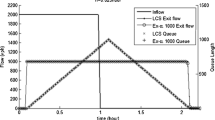Abstract
We develop an approximation scheme, called “pseudo-derivative (PD)” to solving the dynamic user equilibrium (DUE) problem. The PD approximation can convert time-varying, state dependent delays usually involved in DUE to a constant time delay. We study the properties of the proposed PD and the resulting approximate DUE (ADUE) problem after applying the approximation. Some issues of the ADUE, such as the possible violation of the flow conservation at network nodes are also discussed and resolved. It turns out that the original DUE problem can be solved iteratively with an ADUE solved in each iteration. Numerical results are shown on a small test network and the Sioux Falls network. The results show that the iterative algorithm can converge to some reasonable solution, although a formal convergence proof result is not established in the paper.












Similar content being viewed by others
Notes
We notice here that some theoretical results are provided in Friesz et al. (2001) such as the necessary conditions of the optimal control problem with time delays related to DUE, by assuming the time-delay term is differentiable with respect to the state variable. However we still lack a practical tool that can directly analyze and solve such a problem with time-varying, state dependent delays.
References
Ban X, Liu HX, Ferris MC, Ran B (2008) A link-node complementarity model and solution algorithm for dynamic user equilibria with exact flow propagations. Transp Res B 42(9):823–842
Ban X, Pang JS, Liu HX, Ma R (2012a) Continuous-time point-queue models in dynamic network loading. Transp Res B 46(3):360–380
Ban X, Pang JS, Liu HX, Ma R (2012b) Modeling and solving continuous-time instantaneous dynamic user equilibria: a differential complementarity systems approach. Transp Res B 46(3):389–408
Carey M, Ge Y (2012) Comparison of methods for path flow reassignment for dynamic user equilibrium. Netw Spat Econ 12(3):337–376
Ferris M, Munson T (1998) Path 4.6 user manual. Tech. rep., University of Wisconsin at Madison
Friesz TL (2010) Dynamic optimization and differential games. Springer, New York
Friesz TL, Mookherjee R (2006) Solving the dynamic network user equilibrium problem with state-dependent time shifts. Transp Res B 40(3):207–229
Friesz TL, Bernstein D, Smith T, Tobin R, Wie B (1993) A variational inequality formulation of the dynamic network user equilibrium problem. Oper Res 41(1):179–191
Friesz TL, Bernstein D, Suo Z, Tobin R (2001) Dynamic network user equilibrium with state-dependent time lags. Netw Spat Econ 1(3-4):319–347
Friesz TL, Kim T, Kwon C, Rigdon M (2010) Approximate network loading and dual-time-scale dynamic user equilibrium. Transp Res B 45(1):176–207
Kachani S, Perakis G (2009) A dynamic travel time model for spillback. Netw Spat Econ 9(4):595–618
Nie X, Zhang H (2002) The formulation of a link based dynamic network loading model considering queue spillovers. Tech. rep., Department of Civil and Environmental Engineering, University of California, Davis, working Paper UCD-ITS-Zhang-2002-6
Pang JS, Stewart D (2008) Differential variational inequalities. Math Program 113(2):345–424
Peeta S, Ziliaskopoulos A (2001) Foundations of dynamic traffic assignment: the past, the present and the future. Netw Spat Econ 1(3-4):233–265
Ran B, Boyce D (1996) Modeling dynamic transportation networks: an intelligent transportation systems oriented approach. Springer, New York
Shampine L, Thompson S (2001) Solving ddes in matlab. Appl Numer Math 37(4):441–458
Shen W, Zhang H (2008) What do different traffic flow models mean for system-optimal dynamic traffic assignment in a many-to-one network? Transp Res Rec 2088:157–166
Acknowledgments
The authors would like to thank the anonymous referees for their helpful suggestions on an earlier version of the paper. The work of Rui Ma and Xuegang (Jeff) Ban is based on research supported by the National Science Foundation under Grant EFRI 1024647. The work of Jong-Shi Pang is based on research supported by the National Science Foundation under Grants EFRI 1024984 and CMMI 0969600. The work of Henry X. Liu is based on research supported by the National Science Foundation under Grant EFRI 1024604. Any opinions, findings, and conclusions or recommendations expressed in this paper are those of the authors and do not necessarily reflect the views of the National Science Foundation.
Author information
Authors and Affiliations
Corresponding author
Additional information
Submittal to Networks and Spatial Economics (Special Issue for DTA2012 Symposium)
Rights and permissions
About this article
Cite this article
Ma, R., Ban, X.(., Pang, JS. et al. Submission to the DTA2012 Special Issue: Approximating Time Delays in Solving Continuous-Time Dynamic User Equilibria. Netw Spat Econ 15, 443–463 (2015). https://doi.org/10.1007/s11067-014-9240-z
Published:
Issue Date:
DOI: https://doi.org/10.1007/s11067-014-9240-z




